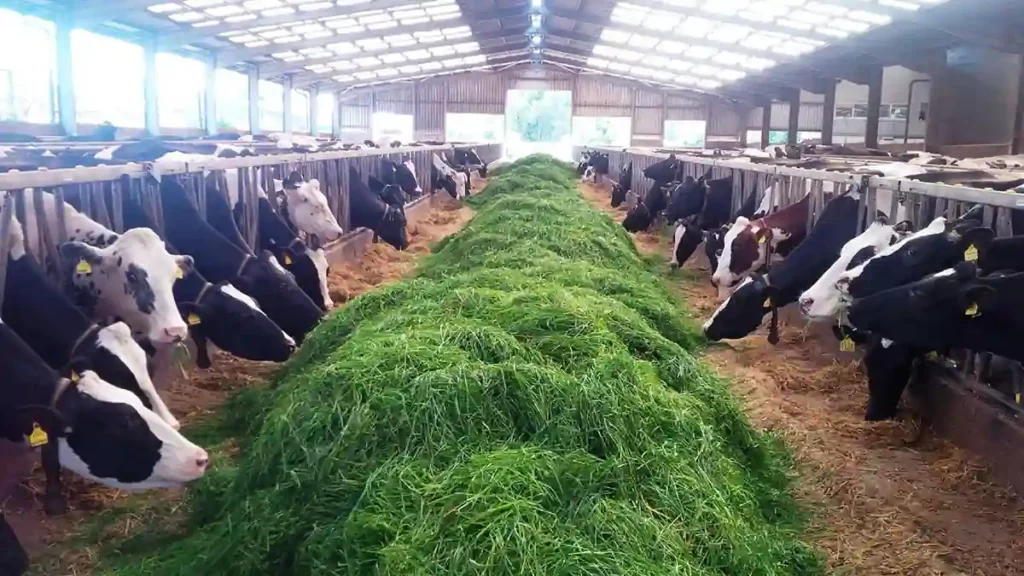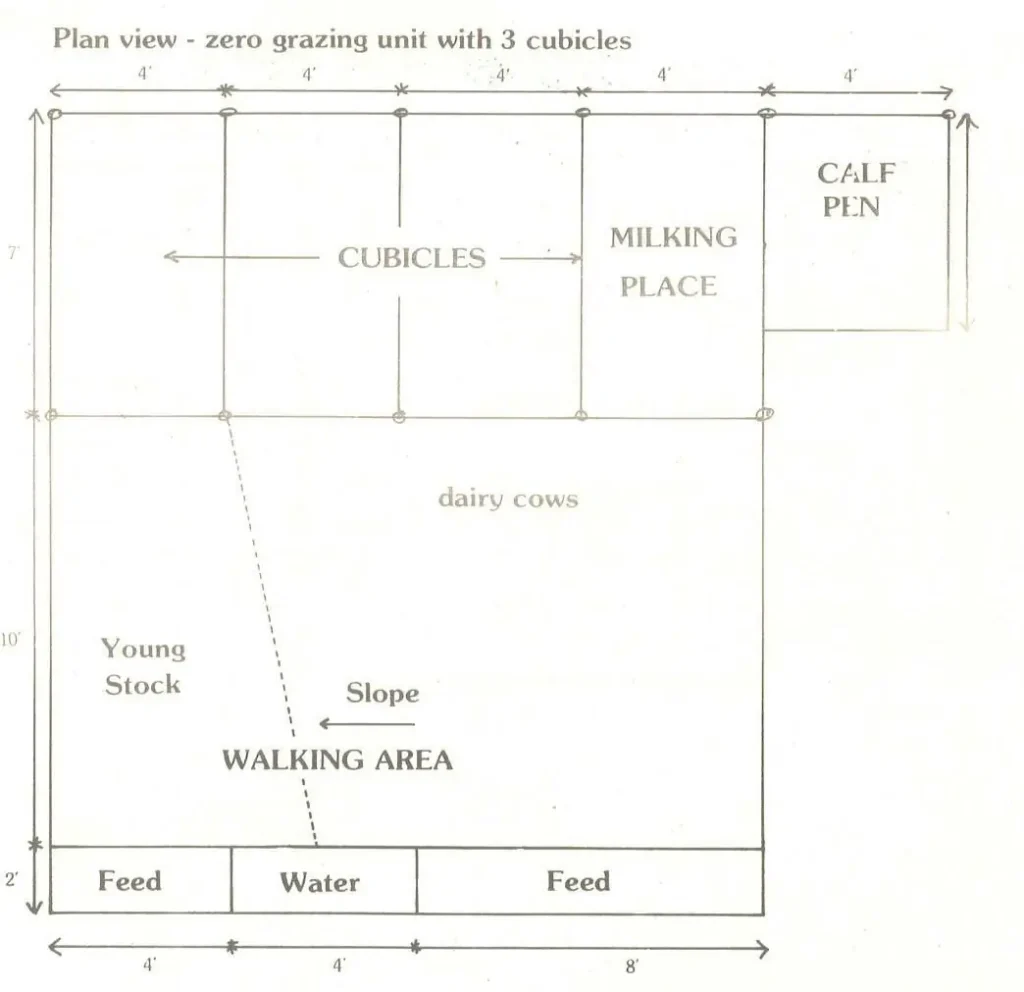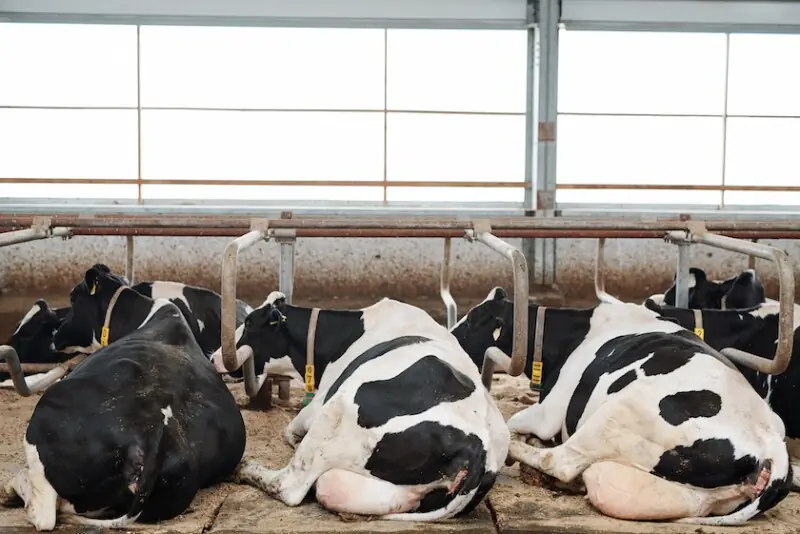Zero Grazing Dairy Farming in Kenya: A Complete Guide
Introduction to Zero Grazing Dairy Farming
Zero grazing dairy farming is transforming agriculture in Kenya. It’s a viable solution for small and large farmers alike. In this system, cattle live in specially designed structures. They are fed through a cut-and-carry method. As land becomes scarce and the demand for milk grows, zeo-grazing farming in Kenya is gaining popularity.
This guide covers:
- What zero grazing is and how it differs from traditional methods
- Key steps to setting up a zero grazing unit, including what infrastructure is needed
- Insights into managing feed and ensuring animal health
- Costs involved and potential returns on investment
- Solutions to common challenges farmers face
For many Kenyan farmers, zero grazing is a game-changer. They can produce up to three times more milk than with traditional methods, using much less land. This approach boosts efficiency. It allows better control over animal health, feeding, and key factors for dairy farming success.
What Is Zero Grazing Dairy Farming?
Zero grazing is an intensive farming method. In this system, cattle are kept in confined areas instead of roaming freely in fields. Farmers can choose to do this full-time, keeping animals housed permanently. Alternatively, they may opt for a part-time approach, allowing cattle to graze outside for half the day before returning to their stalls.

Zero grazing differs from traditional farming. Instead of cows foraging for food, farmers control their diets and living conditions. This method is particularly advantageous in Kenya, where many farmers have small plots. With zero grazing, dairy operations can succeed even in limited spaces. It’s an ideal solution for areas facing land constraints.
| Feature | Zero Grazing | Traditional Grazing |
|---|---|---|
| Animal Confinement | Confined to sheds | Free-roaming in pastures |
| Feed Source | Cut and carried to animals | Animals graze directly on pasture |
| Land Use | More efficient land use; higher stocking density | Requires larger land area for grazing |
| Milk Production | Generally higher due to controlled feeding and improved health | Can vary significantly depending on pasture quality and weather |
| Disease Control | Easier to monitor and control diseases | Higher risk of disease transmission |
| Labor Requirements | Higher labor demand for feeding, cleaning, and manure management | Lower labor requirements, but requires more labor for pasture management |
| Initial Investment | Higher initial investment for infrastructure (sheds, feeding troughs, etc.) | Lower initial investment, but may require fencing and pasture maintenance |
| Environmental Impact | Reduced overgrazing and soil erosion | Potential for overgrazing and soil degradation |
Zero grazing is particularly relevant in Kenya for several reasons:
- Land Constraints: As land becomes scarcer in crowded areas, zero grazing offers a solution for farmers. It’s efficient.
- Enhanced Productivity: This system boosts milk production by improving feed use and conserving energy.
- Disease Control: Keeping animals in confined spaces reduces their exposure to parasites and diseases common in free-range systems.
- Feed Management: During grass shortages, farmers can provide supplementary feeding more effectively, ensuring consistent nutrition year-round.
- Resource Efficiency: The system allows better collection and use of manure, which can be turned into biogas or used as fertilizer, creating an integrated farming system.
Key Benefits of Zero-Grazing Dairy Farming in Kenya
Farmers in Kenya find many advantages to zero grazing, making this method appealing:
1. Increased Milk Production
With zero grazing, farmers manage cows’ diets and feeding times. This approach results in healthier cows. They often produce two to three times more milk than those that graze freely. By mixing the right feeds, farmers ensure cows receive exactly what they need for optimal milk production.
2. Healthier Animals
Cows in well-managed sheds help detect health issues early. Farmers can quickly spot if a cow isn’t eating or shows signs of illness, making it easier to get veterinary care. It also protects cows from diseases and pests they might encounter while grazing.
3. Efficient Land Use
For farmers with little land, zero grazing is a game changer. A small plot that could support one cow now can support three or four with good management. This efficiency makes dairy farming feasible for those with limited space.
4. Environmental Protection
Zero grazing benefits the environment. It prevents overgrazing, which causes soil erosion and land degradation. Farmers can sustainably grow grass and fodder crops. This practice preserves the land for future generations.
5. Cost Savings
Setting up a zero grazing unit requires an initial investment. However, the long-term benefits often outweigh the costs. Farmers spend less on disease treatment and waste fewer resources on feed. They also earn more from increased milk production. Also, they can save money by growing their own fodder crops and making feed mixtures.
Setting Up a Zero Grazing Unit

A. Selecting the Ideal Site
The success of your zero grazing unit begins with selecting the right location. Here are the key factors to consider:
- Water Access: Your site should be close to a reliable water source. Consider adding storage tanks or boreholes if needed.
- Feed Resources: Choose a location near fodder growing areas or feed suppliers. This will help reduce transportation costs.
- Veterinary Services: Being close to veterinary services ensures quick medical attention when necessary.
- Road Access: Good road infrastructure is essential for transporting milk and bringing in supplies.
- Drainage: Proper drainage is crucial to prevent muddy conditions and maintain hygiene on the site.
B. Constructing a Zero Grazing Shed
A well-designed shed is crucial for your cows’ comfort and productivity:
Space Requirements:
- Each cow needs 6-8 square meters of living space
- Walking area: 2-3 meters wide
- Feeding area: 0.6-0.7 meters per cow
- Resting area: 2.1 meters x 1.2 meters per cow
Essential Features:
- Concrete floor with non-slip grooves
- Proper roof height (minimum 2.5 meters) for ventilation
- Feed and water troughs made of concrete or metal
- Waste collection channels and storage pit
- Milking area with easy-to-clean surfaces
Estimated Costs:
- Basic unit (2-3 cows): KSh 80,000-120,000
- Standard unit (4-6 cows): KSh 150,000-250,000
- Premium unit with milking parlor: KSh 300,000+
Parts of a Zero Grazing Unit
A. Cubicles (Sleeping Area)

- Dimensions: 120cm (4ft) wide × 210cm (7ft) long per cow
- Floor elevation: 25cm above walking area
- Materials:
- Floor: Compacted farm soil (cost-effective option)
- Dividers: Wooden rails or posts
- Roofing: Must cover entire sleeping area for weather protection
B. Walking and Manure Area
- Construction material: Concrete mix (1:2:3 ratio of cement:sand:ballast)
- Design features:
- Sloped floor towards manure pit
- Manure pit location: 3 meters from stable
- Surface: Non-slip finish for cattle safety
C. Feeding and Watering Section
- Location: Opposite to sleeping area
- Feed trough specifications:
- Length: 2.5-3ft per cow
- Materials: Wood, stone, or concrete
- Water trough placement:
- Position between cow and young stock areas
- Options: Concrete trough or modified water drum
D. Sun Shade Structure
- Space allocation: 2.5-3m² per animal
- Minimum roof height: 3 meters for proper ventilation
- Orientation options:
- East-West: Best for hot areas (>30°C)
- Requires 3-4m² shade per cow
- Keeps feeding area shaded
- North-South: Ideal for unpaved floors
- Requires 2.5-3m² shade per cow
- Helps keep floor area dry
- East-West: Best for hot areas (>30°C)
E. Additional Essential Features
- Calf pen: Located within main structure
- Fodder chopping area: Near feed storage
- Floor drainage: Proper slopes for waste management
- Ventilation: Adequate spacing between components
C. Feeding and Nutrition
Proper feeding is the backbone of successful zero grazing:
Daily Feed Requirements per Cow:
- Napier grass: 60-70 kg fresh weight
- Dairy meal: 2-8 kg (depending on milk production)
- Mineral supplements: 100-120 grams
- Clean, fresh water: 40-50 liters
Feed Management Tips:
- Establish your own Napier grass plot
- Make silage during plenty to use in dry seasons
- Mix your own dairy meal using local ingredients
- Store hay for emergency feed supply
D. Water Management
Water is critical for milk production and cow health:
Daily Requirements:
- Drinking water: 40-50 liters per cow
- Cleaning: 20-30 liters per cow
- Additional needs during hot weather
Water Management Strategies:
- Install storage tanks (minimum 2,000 liters)
- Set up rainwater harvesting systems
- Implement water recycling where possible
- Regular cleaning of water troughs

10 Cows’ Dairy Farming Business Plan – Ready to Use!
Want to start a profitable dairy farm with 10 cows? This business plan provides a complete roadmap to help you succeed without trial and error!
- ✔ Fully Editable – Download & customize for your farm.
- ✔ Financial Projections – Get clear cost estimates & profit calculations.
- ✔ Investor & Loan-Ready – Impress lenders with a solid plan.
- ✔ Proven Success Strategies – Learn from expert farmers.
Challenges of Zero Grazing in Kenya
While zero grazing offers numerous benefits for dairy farmers in Kenya, the system presents several significant challenges:
1. Infrastructure and Setup Costs
- High initial investment in constructing proper housing units with essential components:
- Cubicles and resting areas
- Concrete walking areas
- Feed and water troughs
- Manure storage facilities
- Need for specialized equipment like fodder cutters and storage facilities
- Costs of installing proper drainage and waste management systems
2. Labor Requirements
- Intensive daily labor for:
- Cutting and carrying fodder
- Regular cleaning of the unit
- Manure collection and disposal
- Feed preparation and distribution
- Need for consistent skilled labor for proper animal care
3. Feed Management Issues
- Challenge of maintaining year-round feed supply
- High costs of supplementary feeds and concentrates
- Labor-intensive fodder cultivation and harvesting
- Storage requirements for feed preservation
- Risk of feed spoilage during storage
3. Animal Health and Welfare
- Increased risk of lameness due to confined conditions
- Higher chances of mastitis if housing isn’t properly maintained
- Stress from confinement affecting milk production
- Need for regular veterinary care and monitoring
4. Technical Knowledge Requirements
- Complex feeding schedules and ratios
- Understanding of animal health management
- Knowledge of proper housing maintenance
- Skills in feed conservation and storage
- Expertise in breeding and reproduction management
5. Resource Management
- High water requirements for cleaning and animal consumption
- Continuous electricity needs for operations
- Environmental concerns from concentrated waste
- Space limitations for feed storage
- Manure handling and disposal challenges
Practical Tips for Success in Zero Grazing Dairy Farming
Farmers can boost zero grazing dairy farming with these practical strategies:
1. Rotational Planting of Fodder Crops
Rotational planting keeps soil fertile and ensures a steady supply of quality fodder. By alternating crops like Napier grass and legumes, farmers enhance nutrients and reduce pests.
2. Keeping Detailed Records
Detailed records of production, feeding, and expenses are vital. They help farmers spot trends and make smart decisions. Regularly reviewing these records can optimize feeding and boost profits.
3. Importance of Veterinary Check-Ups
Regular vet check-ups are key for early disease detection. Farmers should schedule vaccinations, deworming, and health assessments to keep cattle healthy. A proactive health approach can cut vet costs over time.
4. Regular Training for Workers
Ongoing training for farm workers is crucial. Workshops on feeding, disease management, and operations can greatly improve productivity. Informed workers lead to better animal care.
5. Utilizing Technology
Technology can make dairy farming more efficient. Farmers can use apps for records, market access, and vet services. Precision tools also help monitor health and optimize feeding.
6. Diversifying Income Sources
Farmers should diversify income by adding other activities. Growing vegetables or starting agro-tourism can provide extra revenue and maximize land use.
Conclusion
Zero grazing dairy farming enables Kenyan farmers to profit from agriculture. This system boosts milk production, makes efficient use of limited land, and enhances the health and nutrition of the herd.
High initial costs and ongoing management can be challenging. However, the benefits far exceed the drawbacks. Farmers who plan, keep good records, and follow best practices can expect great returns. Given the land pressure in Kenya, it’s very appealing to triple milk production on limited land.
For those thinking about zero grazing, success starts with education and planning. We encourage new dairy farmers to:
- Consult local agricultural extension officers.
- Connect with successful zero grazing farmers nearby.
- Join dairy cooperatives for support and market access.
- Seek training from agricultural institutions.
- Start small and gradually scale up based on experience and resources.
With the right support, zero grazing can make dairy farming successful. Remember, the path to profit starts with one step: learning from those who have succeeded. Seek their knowledge and guidance.

Earn Ksh.120K Monthly from Dairy Farming
Dairy farming in Kenya is one of the most profitable agribusinesses. With the right approach, you can earn Ksh 120,000+ every month. Here’s how:
- ✔ Learn proper feeding & breed selection to maximize milk production.
- ✔ Discover disease management techniques to keep your cows healthy.
- ✔ Get high-paying buyers for your milk & dairy products.
- ✔ Don’t Pay for Expensive Trainings – This guide teaches you everything you need!

